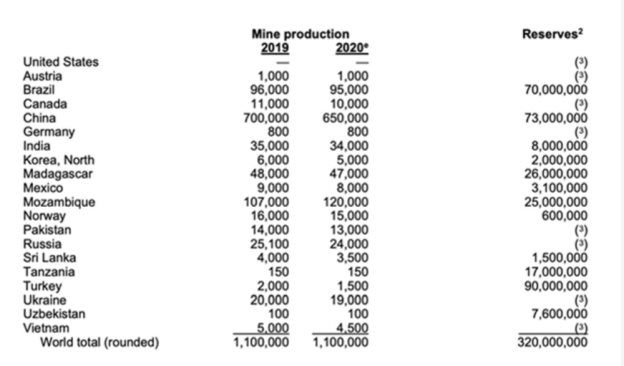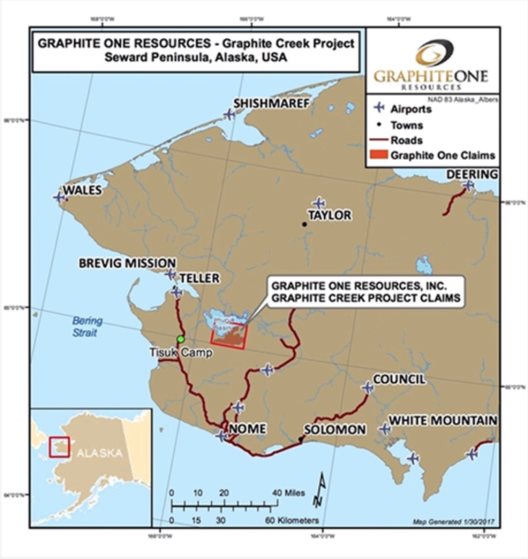
Graphite and
the US metallurgical Achilles' heel
October 28, 2021 -- InvestorsHub
NewsWire -- via Aheadoftheheard.com -- US recognition of the
importance of critical minerals goes back over 100
years.
In
World War I severe material shortages (tungsten, tin, chromite,
optical grade glass, and manila fiber for ropes) played havoc with
production schedules and caused lengthy delays in implementing
programs. This led to development of the Harbord List – a list of
42 materials deemed critical to the military.
A pre-World War II list of
materials contained a total of 29 materials: 14 were strategic
materials that 'must be based entirely or in substantial part on
sources outside the United States.' There were 15 critical
materials that would be easier to source, perhaps even
domestically, than the strategic materials.
The 1939 Strategic Materials Act
authorized US$100 million to purchase strategic raw materials for a
stockpile of 42 strategic and critical materials needed for wartime
production.
By 1940, small amounts of
chromite, manganese, rubber and tin were procured under the
Strategic Materials Act. The purchases certainly weren't enough and
all throughout the war effort these and numerous other materials
had to be imported in large quantities.
After World War II
the United States created the National Defense Stockpile (NDS) to
acquire and store critical strategic materials for national defense
purposes. The Defense Logistics Agency Strategic Materials (DLA
Strategic Materials) oversees operations of the NDS and their
primary mission is to "protect
the nation against a dangerous and costly dependence upon foreign
sources of supply for critical materials in times of national
emergency."
The NDS was
intended for all essential civilian and military uses in times of
emergencies ie guerrilla warfare in Zaire during the 1970s caused
the worldwide price of cobalt to increase from $6 to $45 a pound,
and a United Nations (UN) trade boycott of Zimbabwe (formerly
Rhodesia) stopped legal exports of chromium from the
country.
By 1948 the WIB's Munitions Board
had developed a list of 51 strategic and critical material groups.
By 1950 the number of required materials had expanded to 54 groups,
representing 75 commodities.
Let's fast forward a few
decades…
A concise summary of US mineral
vulnerabilities was presented to the Industrial Readiness Panel of
the House Armed Services Committee in 1980 by General Alton D.
Slay, Commander, Air Force Systems Command. General Slay pointed
out that technological advances had increased the demand for exotic
minerals at the same time as legislative and regulatory
restrictions had been imposed on the US mining industry.
The 1981 report 'A Congressional
Handbook on U.S. Minerals Dependency/Vulnerability' singled out
eight materials "for which the industrial health and defense of the
United States is most vulnerable to potential supply disruptions" –
chromium, cobalt, manganese, the platinum group of metals,
titanium, bauxite/aluminum, niobium and tantalum – the first five
have been called "the metallurgical Achilles' heel of our
civilization."

In 1981, President Reagan
announced a "major purchase program for the National Defense
Stockpile," saying that it was widely recognized that the nation is
vulnerable to sudden shortages in basic raw materials necessary to
its defense production base.
In 1984 US Marine Corps Major
R.A. Hagerman wrote: "Since World War ll, the
United States has become increasingly dependent on foreign sources
for almost all non-fuel minerals. The availability of these
minerals has an extremely important impact on American industry
and, in turn, on US defense capabilities. Without just a few critical minerals, such as
cobalt, manganese, chromium and platinum, it would be virtually
impossible to produce many defense products such as jet engine,
missile components, electronic components, iron, steel, etc. This
places the U.S. in a vulnerable position with a direct threat to
our defense production capability if the supply of strategic
minerals is disrupted by foreign powers."
In 1985, the secretary of the
United States Army testified before Congress that America was more
than 50% dependent on foreign sources for 23 of 40 critical
materials essential to US national security.
The
1988 article "United States Dependence On Imports Of Four Strategic
And Critical Minerals: Implications And Policy
Alternatives" by G.
Kevin Jones was written in regards to what he thought are the most
critical minerals upon which the United States is dependent for
foreign sources of supply – chromium, cobalt, manganese and the
platinum group metals (PGE).
The
May 1989 report "U.S. Strategic and Critical Materials Imports:
Dependency and Vulnerability. The Latin American Alternative,"
deals with over 90 materials identified in the Defense Material
inventories as of September 1987. At least 15 of these minerals are
considered "key minerals" because the US is over 50% import
reliant.
"The United States has consistently maintained that a strong
domestic minerals and metals industry is an essential contributor
to the nation's economic and security interests…The United States
has a fundamental interest in maintaining a competitive minerals
and metals sector that will continue to contribute significantly to
the nation's economic strength and military security. The industry
represents an $87 billion enterprise that employs over 500,000 U.S.
workers and provides the material foundation for U.S.
manufacturing." The
1980 National Academy of Sciences executive summary of
"Competitiveness of the U.S. Minerals and Metals
Industry"
Despite all of
this, in 1992 Congress directed that the bulk of the strategic and
critical materials the US had accumulated in the National Defense
Stockpile be sold.
The primary purpose of the
National Defense Stockpile was to decrease the risk of dependence
on foreign or single suppliers of strategic and critical materials
used in defense, essential civilian, and essential industrial
applications. The NDS Program allowed for decreasing risk by
maintaining a domestically held inventory of necessary
materials.
While
much of the rest of the world was scrambling to tie up control of
strategic minerals America deliberately hamstrung
itself.
Danger Will
Rogers Danger
"Continued
growth in consumption resources is being driven by growth in China
and the rest of Asia. Chinese companies are increasingly acquiring
assets, as are Indian companies, prompting other global miners into
a race to secure mineral assets of their own." George Fang, Standard
Bank's Head of Mining and Metals China
In his 1989 book
"The Rise and Fall of Great Powers" historian Paul Kennedy argues
that a country with a growing economy prefers to become wealthy
instead of funneling its economic output into the military. While
China's, and other developing countries military might has grown
there is no doubt their greatest concern is to secure the needed
energy and raw commodities necessary to continue their economic
expansion.
The global mining
industry is facing stiff new competition in getting deals done. The
new competitor's for the world's resources have a mandate to secure
long term resource deals for domestic use and have the financing
capabilities any major mining company, or for that matter any
government, would be envious of.
China's state
owned enterprises (SOE) and sovereign wealth funds (SWF) were armed
with hundreds of billions of US dollars from the country's foreign
reserves and sent out to scour the globe for resources – they went
on the hunt to fuel China's exploding economy:
-
SOE/SWFs have no problem dealing in
straight cash and operating in what some might consider high risk
areas
-
The Chinese have a longer term
horizon for their ultimate payoff because they are mostly after off-take
supply agreements from early stage development projects
-
The Chinese
government funds infrastructure projects that
secure the cooperation of the host country with regard to mine
development and off-take agreements
-
Thanks to the
trillions of foreign exchange reserves it currently holds
China offers loans at highly competitive interest rates. For example,
the Export-Import Bank of China (Exim Bank) gave the Angolan
government three loans at interest rates ranging from LIBOR (London
Interbank Offered Rate – the rate banks charge each other on loans)
plus 1.25 percent, up to LIBOR plus 1.75 percent, as well Exim Bank
offered generous grace periods and long repayment terms
The future
production from the deposits that the Chinese, Indians and others
have acquired and developed through state-owned entities flows
directly back to their respective countries bypassing the global
commodity markets.
Critical to the economic and national security of the United
States
Things began to change under
former President Trump, it had to - the US is 100% reliant on imports of 13 critical
minerals.
In 2017 former President Trump
signed an executive order to encourage the exploration and
development of new US sources of these metals.
In December 2017, the U.S.
Geological Survey released its Professional
Paper 1802 titled "Critical Mineral Resources of the United States—
Economic and Environmental Geology and Prospects for Future
Supply".
A critical mineral is defined as
a mineral:
-
Identified to be a nonfuel
mineral or mineral material essential to the economic and national
security of the United States
-
From a supply chain that is
vulnerable to disruption
-
That serves an essential function
in the manufacturing of a product, the absence of which would have
substantial consequences for the U.S. economy or national
security
The report represented the U.S.
Government's most comprehensive assessment of the nation's mineral
resource profile and potential, serving to inform federal mineral
policy.
The report lists 23 metals and
minerals that are critical to "the national economy and national
security of the United States."
In 2018, the US
Government's Critical Minerals List was published.
"The
United States is heavily reliant on imports of certain mineral
commodities that are vital to the Nation's security and economic
prosperity. This dependency of the United States on foreign sources
creates a strategic vulnerability for both its economy and military
to adverse foreign government action, natural disaster, and other
events that can disrupt supply of these key minerals."

On February 24, 2021, President
Joe Biden signed an executive
order (EO) aimed at
strengthening critical U.S. supply chains. Graphite was identified
as one of four minerals considered essential to the nation's
"national security, foreign policy and economy."
"The
United States needs resilient, diverse, and secure supply chains to
ensure our economic prosperity and national security. Pandemics and
other biological threats, cyber-attacks, climate shocks and extreme
weather events, terrorist attacks, geopolitical and economic
competition, and other conditions can reduce critical manufacturing
capacity and the availability and integrity of critical goods,
products, and services."
The EO identifies three
technology sectors as critical supply chains:
-
Advanced
semiconductors
-
High-capacity batteries,
including Electric Vehicle (EV) batteries
-
Pharmaceuticals
The EO also identifies "critical
minerals and other… strategic materials" as a fourth supply chain,
essential to technology manufacturing and the Defense Industrial
Base.
Graphite is a critical mineral
and an essential material for both the renewable and EV Battery
sectors, and for advanced semiconductor
manufacturing.
Graphite is:
-
One of 14 Listed
Minerals for which the U.S. is 100% import-dependent
-
One of 9 Listed
Minerals meeting all 6 of the industrial/defense sector indicators
identified by the U.S. Government report
-
One of 4 Listed
Minerals for which the U.S. is 100% import-dependent while meeting
all 6 industrial/defense sector indicators
-
One of 3 Listed
minerals which meet all industrial/defense sector indicators – and
for which China is the leading global producer and leading U.S.
supplier
The U.S Government's Draft
Critical Minerals List report on graphite stated that
"China is by far
the largest producer of natural graphite, accounting for roughly
two-thirds of world production. Only 4 percent of the world's
natural graphite comes from North America, with no U.S. production
in decades. Although natural graphite was not produced in the
United States in 2016, about 98 U.S. firms, primarily in the
Northeastern and Great Lakes regions, consumed graphite in various
forms from imported sources for use in brake linings, foundry
operations, lubricants, refractory applications, and
steelmaking. Graphite's use in
rechargeable batteries, as well as technologies under development
(such as large-scale fuel-cell applications), could consume as much
graphite as all other uses combined."
There is no substitute for
graphite in an EV battery and lithium-ion batteries are expected to
be the technology that runs electric vehicles for the foreseeable
future, making graphite indispensable to the global shift towards
clean energy.
The mineral is sourced from only
a few places. China currently is the world's biggest producer, with
650,000 tonnes of mined graphite in 2020, representing nearly 70%
of global supply.
After China, the next leading
graphite producers are Mozambique, Brazil, Madagascar, Canada and
India. The United States does not produce any natural graphite and
therefore must rely solely on imports to satisfy domestic
demand.
2020 mined
graphite production. Source: USGS
The level of foreign dependence
has increased over the years. The US imported 38,900 tonnes of
graphite in 2016 and 70,700t in 2018.
According to the USGS, in 2020
the US imported 42,000 tons, of which 71% was high-purity flake
graphite, 28% was amorphous, and 1% was lump and chip graphite. The
top importers were China (33%), Mexico (23%), Canada (17%) and
India (9%). But remember, the US is not 33% dependent on China for
its battery-grade graphite, but 100%, since China controls all
spherical graphite processing.
It's thought that the increased
use of lithium-ion batteries could gobble up well over 1.6 million
tonnes of flake graphite per year (out of a total 2020 market, all
uses, of 1.1Mt) — only flake graphite, upgraded to 99.9% purity,
and synthetic graphite (made from petroleum coke, a very expensive
process) can be used in lithium-ion batteries.
The USGS believes that
large-scale fuel cell applications are being developed that could
consume as much graphite as all other uses combined.
Can the mining industry crank out
more graphite every year to match this demand? Color me skeptical.
Between 2018 and 2019, world mine production actually declined by
20,000 tonnes, or 1.8%. Global production in 2019 and 2020 was
exactly the same, 1.1 million tonnes.
Currently there are no producing
graphite mines in the United States, and only 10,000 tonnes a year
is being mined from two facilities in Canada. The fact is, for the
United States to develop a "mine to battery" supply chain at home,
it currently has no choice but to import its raw materials from
foreign countries.
For battery-grade graphite, that
means China, which is growing increasingly adversarial, in terms of
trade, foreign policy and militarily.
Even if the US wants to keep
importing its graphite, doubts have been raised over whether China
could keep up with surging global demand. The top producer has
already taken steps to retain its graphite resources by restricting
its export quota and imposed a 20% export duty.
In short, the days of affordable,
abundant graphite from China are numbered, adding further urgency
for the US to develop its own supply.
The demand for graphite is only
headed in one direction. A White House report on critical supply
chains showed that graphite demand for clean energy applications
will require 25 times more graphite by 2040 than was produced
worldwide in 2020.
We have clearly reached a point
when much more graphite needs to be discovered and
mined.
Graphite
One
Earlier this year, the Federal
Permitting Improvement Steering Committee (FPISC) granted
High-Priority Infrastructure Project (HPIP) status
to Graphite
One Inc. (TSXV:GPH,
OTCQX:GPHOF), which is aiming to develop America's first
high-grade producer of coated spherical graphite (CSG) integrated
with a domestic graphite resource at Graphite Creek,
Alaska.
The HPIP designation allows
Graphite One to list on the US government's Federal Permitting
Dashboard, which ensures that the various federal permitting
agencies coordinate their reviews of projects as a means of
streamlining the approval process.
Graphite Creek is the
highest-grade and largest known flake graphite deposit in the US,
spanning 18 km.

The Graphite
Creek property is located 55 km north of Nome, Alaska.
The project is envisioned as a
vertically integrated enterprise to mine, process and manufacture
Coated Spherical Graphite ("CSG") for the lithium-ion electric
vehicle battery market. Graphite One aims to become the first US
vertically integrated domestic producer to serve the US EV battery
market.
The latest resource estimate
(March 2019) for Graphite Creek showed 10.95 million tonnes of
measured and indicated resources at a graphite grade of 7.8% Cg,
for some 850,000 tonnes of contained graphite. Another 91.9 million
tonnes were tagged as inferred resources, with an average grade of
8.0% Cg containing 7.3 million tonnes.
A preliminary
economic assessment (PEA) for the project envisions a 40-year
operation with a mineral processing plant capable of producing
60,000 tonnes of graphite concentrate (at 95% purity) per
year.
"With the recent $21-million in
funding, our efforts have progressed towards completion of the PFS
for the largest known and highest-grade graphite deposit in the
United States. The 2021 field program also initiated the drilling
and additional data collection needed to begin work on the FS after
the PFS is completed. We are very pleased with the successful
execution of the 2021 field program as historical drilling, coupled
with the new data, clearly demonstrates the predictability and
consistency of high-grade, near-surface graphite. With the concepts
and conclusions outlined in the PEA suggesting a 40-year mine life,
the Graphite Creek deposit continues to show potential to be an
essential long-life component of the graphite supply chain, one of
four critical minerals that are on the U.S. National Defense
stockpile list. While the PEA demonstrated the project's economic
viability, we expect these further studies with their optimized
plans for the mine and processing facilities to support improved
economics." Anthony Huston, chief executive officer of Graphite
One.
Once in full production, Graphite
One's proposed graphite products manufacturing plant — the second
link in its proposed supply chain strategy — is expected to turn
graphite concentrates into 41,850 tonnes of battery-grade coated
spherical graphite and 13,500 tonnes of graphite powders per
year.
Material produced from Graphite
Creek would be almost sufficient to supply the entire nation's
graphite demand given current import totals.
But these production figures were
based on resource estimates prior to the 2019 update, leaving room
for potentially higher production.
Conclusion
Many do not realize do not
realize that without graphite, lithium-ion batteries cannot be
made. There is no substitution for graphite in a lithium battery
anode, making graphite as crucial to the green-energy transition as
lithium itself.
That fact should sound the alarm
for those following graphite demand and supply.
For many years the United States
didn't mind being dependent on out-of-country suppliers for
critical minerals like graphite. It was convenient. But today
convenience is being replaced with understanding the role of
critical minerals in a nation's economic health and military
strength.
Critical minerals are finally
getting the attention they deserve.
Graphite One is a company on the
move with the largest and highest-grade flake graphite deposit in
the United States.
What GPH has discovered so far
though is only a small portion of the geological trend under
consideration. I believe Graphite Creek will become a mine and that its production will
supply a large percentage of US domestic graphite demand. I
therefore see GPH as an important link in America's burgeoning
"mine to battery" supply chain which is why I own
shares.
Graphite One
Inc.
TSXV:GPH,
OTCQX:GPHOF
Cdn$1.56, 2021.10.26
Shares Outstanding
81.5m
Market cap Cdn$129.9m
GPH website
Richard (Rick)
Mills
aheadoftheherd.com
subscribe
to my free newsletter
Legal Notice
/ Disclaimer
Ahead of the Herd
newsletter, aheadoftheherd.com, hereafter known as AOTH.
Please read the
entire Disclaimer carefully before you use this website or read the
newsletter. If you do not agree to all the AOTH/Richard Mills
Disclaimer, do not access/read this website/newsletter/article, or
any of its pages. By reading/using this AOTH/Richard Mills
website/newsletter/article, and whether you actually read this
Disclaimer, you are deemed to have accepted it.
Any AOTH/Richard
Mills document is not, and should not be, construed as an offer to
sell or the solicitation of an offer to purchase or subscribe for
any investment.
AOTH/Richard Mills
has based this document on information obtained from sources he
believes to be reliable, but which has not been independently
verified.
AOTH/Richard Mills
makes no guarantee, representation or warranty and accepts no
responsibility or liability as to its accuracy or
completeness.
Expressions of
opinion are those of AOTH/Richard Mills only and are subject to
change without notice.
AOTH/Richard Mills
assumes no warranty, liability or guarantee for the current
relevance, correctness or completeness of any information provided
within this Report and will not be held liable for the consequence
of reliance upon any opinion or statement contained herein or any
omission.
Furthermore,
AOTH/Richard Mills assumes no liability for any direct or indirect
loss or damage for lost profit, which you may incur as a result of
the use and existence of the information provided within this
AOTH/Richard Mills Report.
You agree that by
reading AOTH/Richard Mills articles, you are acting at your OWN
RISK. In no event should AOTH/Richard Mills liable for any direct
or indirect trading losses caused by any information contained in
AOTH/Richard Mills articles. Information in AOTH/Richard Mills
articles is not an offer to sell or a solicitation of an offer to
buy any security. AOTH/Richard Mills is not suggesting the
transacting of any financial instruments.
Our publications
are not a recommendation to buy or sell a security – no information
posted on this site is to be considered investment advice or a
recommendation to do anything involving finance or money aside from
performing your own due diligence and consulting with your personal
registered broker/financial advisor.
AOTH/Richard Mills
recommends that before investing in any securities, you consult
with a professional financial planner or advisor, and that you
should conduct a complete and independent investigation before
investing in any security after prudent consideration of all
pertinent risks.
Ahead of the Herd
is not a registered broker, dealer, analyst, or advisor. We hold no
investment licenses and may not sell, offer to sell, or offer to
buy any security.
Richard owns shares of
Graphite One
Inc. (TSXV:GPH).
GPH is a paid advertiser on his site aheadoftheherd.com
SOURCE: aheadoftheheard.com